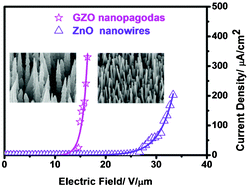Experimental and computational insights in the growth of gallium-doped zinc oxide nanostructures with superior field emission properties
Abstract
Well-aligned, single-crystalline Ga-doped ![[1 with combining macron]](https://www.rsc.org/images/entities/char_0031_0304.gif) 00} to two sets of facets: ({11
00} to two sets of facets: ({11![[2 with combining macron]](https://www.rsc.org/images/entities/char_0032_0304.gif) 1}, {11
1}, {11![[2 with combining macron]](https://www.rsc.org/images/entities/char_0032_0304.gif)
![[2 with combining macron]](https://www.rsc.org/images/entities/char_0032_0304.gif) }) and ({
}) and ({![[2 with combining macron]](https://www.rsc.org/images/entities/char_0032_0304.gif) 201}, {
201}, {![[1 with combining macron]](https://www.rsc.org/images/entities/char_0031_0304.gif) 10
10![[1 with combining macron]](https://www.rsc.org/images/entities/char_0031_0304.gif) }), which eventually led to a pagoda shape. Based on computational simulation results, gallium lowers the surface energies of the ({11
}), which eventually led to a pagoda shape. Based on computational simulation results, gallium lowers the surface energies of the ({11![[2 with combining macron]](https://www.rsc.org/images/entities/char_0032_0304.gif) 1}, {11
1}, {11![[2 with combining macron]](https://www.rsc.org/images/entities/char_0032_0304.gif)
![[2 with combining macron]](https://www.rsc.org/images/entities/char_0032_0304.gif) }) and ({
}) and ({![[2 with combining macron]](https://www.rsc.org/images/entities/char_0032_0304.gif) 201}, {
201}, {![[1 with combining macron]](https://www.rsc.org/images/entities/char_0031_0304.gif) 10
10![[1 with combining macron]](https://www.rsc.org/images/entities/char_0031_0304.gif) }) planes but increases that of the {1
}) planes but increases that of the {1![[1 with combining macron]](https://www.rsc.org/images/entities/char_0031_0304.gif) 00} plane. We proposed a new growth model, which involves the change of surface energy calculated by computational simulation due to Ga doping, to interpret why the smooth {1
00} plane. We proposed a new growth model, which involves the change of surface energy calculated by computational simulation due to Ga doping, to interpret why the smooth {1![[1 with combining macron]](https://www.rsc.org/images/entities/char_0031_0304.gif) 00} planes of
00} planes of ![[2 with combining macron]](https://www.rsc.org/images/entities/char_0032_0304.gif) 1}, {11
1}, {11![[2 with combining macron]](https://www.rsc.org/images/entities/char_0032_0304.gif)
![[2 with combining macron]](https://www.rsc.org/images/entities/char_0032_0304.gif) }) and ({
}) and ({![[2 with combining macron]](https://www.rsc.org/images/entities/char_0032_0304.gif) 201}, {
201}, {![[1 with combining macron]](https://www.rsc.org/images/entities/char_0031_0304.gif) 10
10![[1 with combining macron]](https://www.rsc.org/images/entities/char_0031_0304.gif) }) planes of nanopagodas. The nanopagodas not only possess excellent crystal quality but also exhibit remarkable field emission properties. Field emitters made of Ga-doped ZnO nanopagodas had a low turn-on field due to the decrease of work function and the increase of conductivity caused by Ga; simultaneously, the interesting pagoda shape enhanced significantly the field emission β values by 18 times.
}) planes of nanopagodas. The nanopagodas not only possess excellent crystal quality but also exhibit remarkable field emission properties. Field emitters made of Ga-doped ZnO nanopagodas had a low turn-on field due to the decrease of work function and the increase of conductivity caused by Ga; simultaneously, the interesting pagoda shape enhanced significantly the field emission β values by 18 times.


 Please wait while we load your content...
Please wait while we load your content...